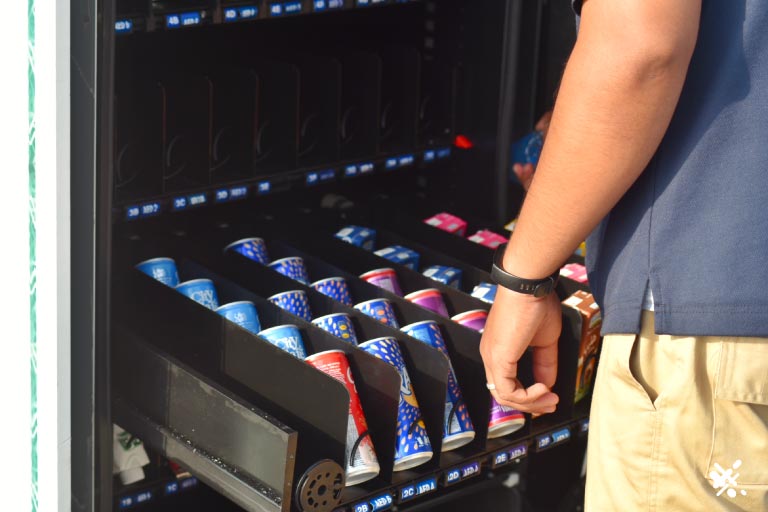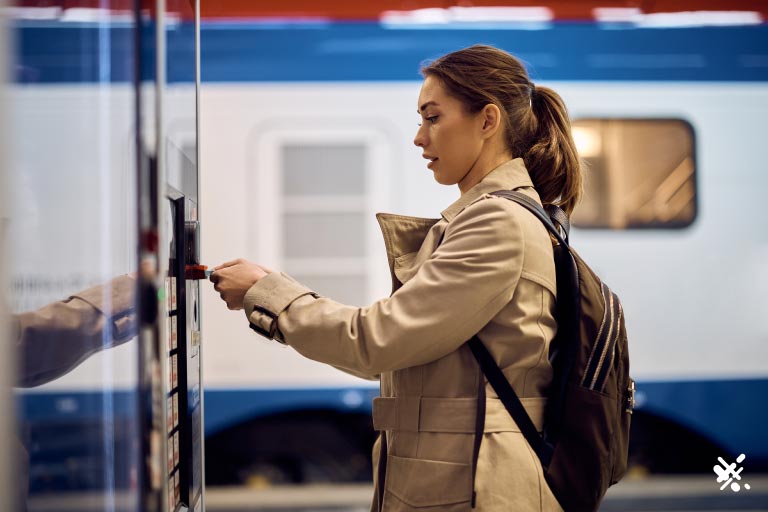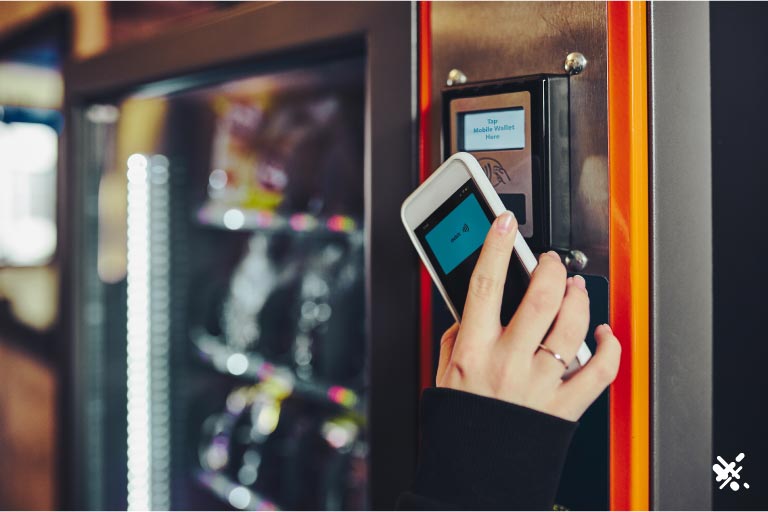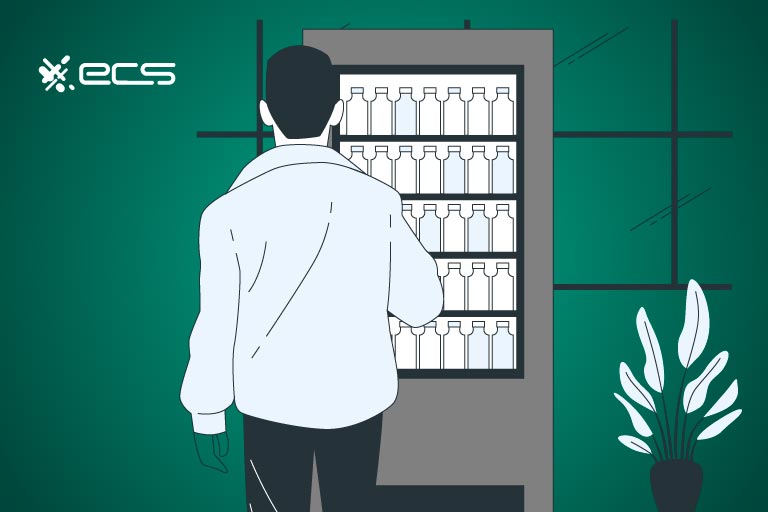These days, most consumers are not carrying cash. And if vending machines have not already made the transition from coin slots to cash to cashless devices for taking payment, they’ll soon need to. This article will examine how vending machine card readers can accept debit cards, credit cards, QR codes, and digital wallet mobile payments to accept a wider variety of transaction types.
But First…Who Invented The First Vending Machine?
The image of a vending machine that permeates our cultural consciousness is a glass panel of candy bars, chips, and soda. But the first vending machine was designed in the first century by Hero of Alexandria, Egypt (yes, Hero was his name).
It did not distribute meatball sandwiches but rather sacred water. A deposited coin fell onto a pan attached to a lever, which in turn opened a water valve. The pan tilted until the coin fell off, and a counterweight shut the valve.
Coin-operated vending machines were seen once more in the 16th-century taverns of Olde Englande, where they distributed ye olde cigarettes. These machines were brass-made and portable, creating a small vending machine industry. Then, a British inventor appropriated the idea of creating a vending machine for selling banned books in 1822.

Vending Machines Grow in Popularity
Another British inventor was awarded a patent for an automated stamp vending machine in 1867. Postcards followed in the 1880s. These were the first vending machines to gain widespread popularity. Their placement was coupled with another exciting technology of the times: the steam engine. So, postcard vending machines were placed in railway stations. The two newest technologies lived side-by-side.
In 1893, a German chocolate company started selling their confectionary out of 15,000 vending machines. It established a conglomerate to manage an empire of machines selling cigarettes, matches, chewing gum, and hygienic products like soap.
Vending machines did not make it across the pond until 1888. The Thomas Adams Gum Company created a line of gum machines around New York City train platforms. The Pulver Manufacturing Company then had the idea to add an element of gamification to vending machines, making mechanical figures that would move around with every purchase.
When Vending Machines Were Slot Machines
These mechanically animated vending machines were called trade simulators, and they combined vending with a game of chance. In this way, they were very comparable to today’s slot machines. They were frequently found in cigar stores, saloons, and confectionary shops.
These machines were used in states where gambling was prohibited to get around the prohibition. Gamers would put their coins into the machine, pull the lever, and see if they could get awarded a product (like gum or candy) or a meal.
Today, slot machines and vending machines are in two very separate categories. Gambling has become a very regulated industry, and in most states, you cannot just put a slot machine in a space with a lot of foot traffic. But you can put a vending machine there to sell food, drinks, or whatever products you think will sell.
Vending Machine Global Market Stats
The global retail vending machine market valuation was already beyond $52 billion as of 2022 and is expected to increase at a CAGR of 10.7% over the next decade. Interestingly, the largest footprint in the vending machine space is in manufacturing locations (30.2%), followed by offices (25.4%), hotels (12.7%), schools (9.9%), retail locations (7.3%), hospitals (6.2%), military bases (4.7%), and bars and clubs (3.5%).
Around 33% of the world’s vending machines are in the United States, which says something interesting about American culture. One thinks of those Edward Hopper paintings of lonely people sitting in urban automats (a staffless diner where all the food is served from vending machines). In fact, automats are making a comeback, somewhat spurred on by pandemic trends toward reduced human contact.

Vending Machines: A Small Business Industry
Strangely, only about 2 million out of the 5 million domestic vending machines are currently operating, but they pull in about $7.4 billion for their owners. The vending machine market is very much a small business space, with 67% of operators falling into the small business category (revenue of less than $1 million). Around 16.5% of operators make between $1 and $4.9 million, 7% make between $5 and $9.9 million, and 9.4% make $10 million or more.
Some large corporations like Pepsi and Coca-Cola own a significant amount of their branded machines. But the profit margin on each machine is very narrow. There are many moving parts and logistical considerations (like restocking). This makes vending machines better suited for small business owners with lower overhead costs (e.g., a home-based business owner-operator).
In fact, the 2 million operating machines are owned by 17,600 different businesses, many of which have no more than a few people. The startup costs are relatively low, with one machine and inventory usually costing under $2,000. It’s a business with a flexible schedule and is fairly passive, with restocking and cash collection being the only things routinely involved.
Vending Machine Market Challenges
But it certainly has its challenges. Many of the best locations for machines are already saturated. New machines are expensive, leading many first-times to explore used machines. But businesses do not want old machines on their premises.
It’s somewhat of a dog-eat-dog world out there, with one survey finding that the average owner had 13 machines, each grossing $309 per month. Many vending machine owners will tell you that a lot of it comes down to the main rule of real estate: location, location, location!
In any case, getting into the best practices of placing and servicing vending machines is a story for a different day. We are here to talk about the vending machine credit card reader.
What Do Vending Machines Typically Sell?
But before we get there, let’s capture some last interesting stats. These, in turn, may inform the discussion about vending machine payment systems. Around 38.7% of machines are selling snacks and other foods (chips, pretzels, candy bars, pastries, sandwiches), 33.7% are selling beverages (primarily cold, but 2.5% are selling hot coffee), 12.6% are selling bulk candy (like gumballs), 7.9% are selling healthy snacks, and 7.1% are selling other items (toys, stickers, hygiene products, as a few examples).
Some of the more bizarre product offerings are live crabs ($4), Beluga caviar ($500), engagement rings ($800), and a dozen earthworms for fishing ($3.50). But aside from these interesting product lines, most are “full-line” machines selling standard snack food.
You may see the need for a vending machine card reader with big-ticket items. After all, consumers typically do not carry around enough cash to buy Beluga caviar. But do you need a card vending machine for everyday staples that cost just a few dollars?

Vending Machine Card Readers
Cashless vending machine transactions increased from 51% in 2020 to 62% in 2021. Meanwhile, cash transactions fell from 49% to 38%. Of course, you could infer the second set of statistics from the first, but you can see from the numbers that cash payments are declining. The increase in cashless transactions was due to many merchants utilizing vending machine card readers.
Moreover, contactless transactions are particularly on the rise. 46% of 2019 sales were made with magnetic stripe credit card swipes, while just 15% were contactless. One year later, 57% were made with magnetic stripes, and 25% were made with contactless payments—a 66% increase. This reveals a strong consumer trend away from cash and towards cards.
It is worth commenting that magnetic stripe payments increased from 2019 to 2020. This is certainly coupled with the decline in cash usage. Contactless payments are a relatively new form of technology that older consumers are not as familiar with or hesitant to use. The magnetic swipe is a far more familiar payment gesture.
Bye Bye, Magnetic Strips
But magnetic strips will be going away by 2033. Visa and Mastercard are already phasing them out in select locations. Stripe payments have been almost entirely supplanted in stores by EMV chip insertions and contactless payments.
Magnetic stripe payments may be lingering in the vending machine space because a substantial portion of America’s two million machines may be at least five years old. Recall that many vending machine owners are small businesses, and the cost of repurposing an older machine is significantly lower than purchasing a new one.

Consumers and Cash Trends
But within just a few years, these vending machine owners will be forced to re-evaluate the payment options they present to consumers. The magnetic strips will be gone for good, and consumers have already shown that they do not like carrying cash.
41% of polled Americans didn’t make any purchases in cash in 2022. And just 56% of them carried cash when they left their home. Consumers aged 35-44 only use cash 13% of the time, and the average person carries around $67 or less in cash (less, according to other polls). While $67 is not a problem for someone looking to collect a handful of dollars for snack food, these other numbers represent bad odds for cash-only vending machines.
Vending Machine Cash Risks
Vending machines actually make poor targets for criminals in search of cash. For one thing, there is no telling if, after vandalizing the machine, a criminal will find $600 or just $25. It brings it all back to those days when vending machines were a form of gambling. But sometimes criminals will strike vending machines, damaging the machine and making off with hundreds of dollars.
Theft of the items in the vending machine may be more common. Hungry or thirsty people have several ways to score a tube of Pringles. This may include using fake coins or even washers to fool the machine into dispensing food. It may involve breaking into the machine or reaching in and up to snatch loose items.
It may involve explosives or elaborate catch-me-if-you-can type schemes to impersonate service mechanics and steal almost a million dollars in loose change (Vegas is a pretty wild place, what can we say).’
Criminals have also been known to insert counterfeit paper money into vending machines to steal change and enjoy a Coke while they’re at it. Of course, installing security cameras around your vending machines can go a long way toward deterring some of this crime. But if a vending machine were not to accept cash, it could reduce a significant amount of theft.
Vending Machine Mag Stripe Risks
But eliminating cash payments is not enough. Magnetic stripes also pose a significant risk. And vending machines are particularly vulnerable in this regard because they are unattended. The type of theft with magnetic strips is called “card skimming.”
Card skimmers are small devices installed on, in, or around magnetic strips. They capture information on the magnetic strip and send it wirelessly to someone waiting nearby. This criminal can then use the information to manufacture fake cards or shop online with stolen card information.
Card skimming typically occurs at locations where a POS terminal is unattended, like gas station pumps and vending machines. It can take just 3 seconds to install a card skimmer, meaning a criminal could pose as a customer, leaving behind a skimmer on the vending machine card reader while they grab some Skittles. Taste the rainbow.

Contactless Payment Solutions
The next generation of payment technology was (and is) the EMV chip. EMV chips have actually been used in Europe for decades but did not catch on in the United States until later.
Today’s chips generate random, encrypted codes that send payment information to the card network. Therefore, every single transaction is unique, foiling card skimmers. Card skimming works only if the information stolen by skimmers on the vending machine card reader is permanent or static.
But if vending machine sales are going to upgrade to the latest technology, they might as well go right to contactless payments. These types of payments do not require any swiping or chip insertion. All the customer needs to do is hold their card up to the vending machine card reader, and within one or two seconds, the payment is complete.
Around 51% of US consumers already regularly use contactless payments, a trend that is accelerated by the fact that by 2026, eight out of ten cards will be contactless. 65% of consumers believe contactless payments are cleaner than traditional swipes and keypads. And 73% of consumers who use contactless payments regularly cited convenience as a reason for using them.
Vending Machines and Mobile Payments
One subset of contactless payments is mobile payments. Mobile apps like Google Pay and Apple Pay link to bank accounts. There are also digital wallets for storing information from actual plastic debit and credit cards. When customers want to pay for something, they can open the wallet or app and bring the phone close to the payment terminal.
Much like contactless credit cards, mobile wallet technology works with radio waves. An NFC chip (near-field communication) is activated and communicates with the payment terminal to complete the payment. Consumers have responded positively to contactless payments, with an adoption rate of 43.2 per 100 consumers in the United States.
In fact, mobile payment usage is growing faster than plastic card usage. Contactless mobile payments are expected to grow by 221% by 2026, while contactless card payments are expected to grow by 119% in the same period. Mobile payments outstripping card payments show that consumers are looking to lighten the load in their pockets. They don’t want cash. Not even cards. They only want their phones.

Vending Machines in The Future
This brings us to an interesting tangent in the payment landscape, which is biometric payments. Right now, most mobile wallet applications already require some sort of biometric for unlocking the wallet: a fingerprint, an eye scan, or a facial (not one with cucumbers). But in the future, consumers may see these biometrics migrate to the POS itself.
Mastercard and Visa have already rolled out pilot programs for biometric payments. Consumers register their biometric information with the card network. They can then go to a payment terminal and undergo a facial scan. If the scan matches their registered biometric data, then the transaction can be completed.
Around 60% of consumers already believe that biometric verifiers are more secure than a password or PIN. And roughly the same percentage believe that paying with biometrics would be easier than paying with a card. While some consumers do have concerns about registering their biometric data, this will likely be a normative payment option within the next decade—including the vending machines.
And vending machines may also become a more prevalent part of the retail landscape, not just for satisfying momentary, snack-related cravings. Many tech startups have been experimenting with pizza vending machines. Amazon has been experimenting with vending machines that are like miniature convenience stores. But main street entrepreneurs with similar ideas hope to beat the Bezos Behemoth.
In all, as our culture becomes more automated and contactless, vending machines may play an even more critical role. And they will require payment solutions that transcend collecting dollar bills and coins. For now, those solutions should require contactless payment options with a vending machine card reader.
QR Codes and Proprietary Apps
Another interesting form of payment tech for vending machines is the QR code. With QR codes, consumers scan a black-and-white pattern with their phones. They are then directed to a payment gateway on the internet.
After making a payment, several mechanisms may allow them access to their product or service. They could get a code to punch in. Or the machine could dispense something or open up automatically.
Similar payment technology is found with proprietary apps. One common application for this technology is community-based services like a laundromat or laundry room. Consumers register payment information on an app or platform. After making payments, the company unlocks a specific device (like a washing machine or dryer) for the customer.
These types of software solutions do require customers to have a mobile phone. But they also eliminate the need for POS hardware. However, it is still advisable to have POS hardware on your vending machines because some customers will still want to use actual plastic cards, and some will want to use contactless mobile payments. Both of which can be done through the installation of a vending machine card reader.
Payment Processing For Vending Machines
Working with a transparent company is essential when choosing a payment processor. Vending machines have a low-profit margin per machine, and the wrong type of fee structure can grossly eat away at your profits.
A flat-rate pricing structure may be particularly bad for vending machines. In this pricing model, all transactions cost the same percentage plus a flat fee. Can you imagine paying 2.6% plus a dime for every purchase?
That means on a $3 Coke, you’ll be making around $2.80. Subtracting the cost of inventory, labor, and repairs, your profit margin on each item is sinking lower and lower.
Interchange plus pricing is probably your best payment model. In this model, each transaction reflects the actual cost of running it through the card networks, plus some markup for the payment processor.
It’s also important to discuss with your payment processor if and how they distinguish debit charges from credit charges. Debit charges go through separate card networks and can cost less than credit card charges. But some payment processors will run them all through the same card network, costing the merchant more than they should pay.
We’d love to connect if you have any questions about vending machine card readers or vending machine payment processing. You may wonder how to integrate software and hardware changes with your machines. We’d be happy to answer that question and any others you have. Give us a call or fill out the contact form below to learn more.
